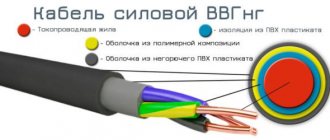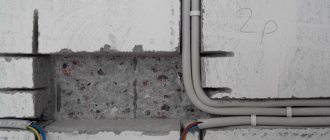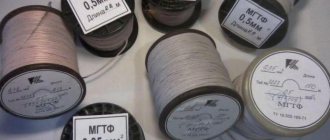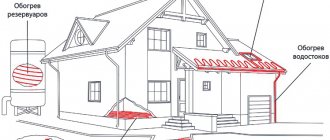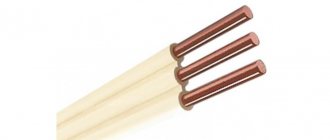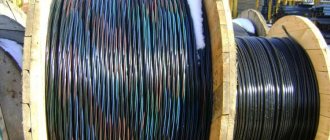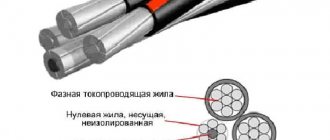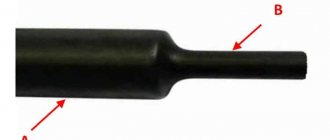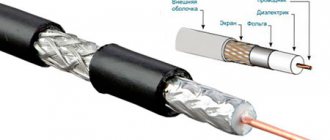Purpose, scope, marking
VVG power wire is applicable for installation of power supply lines, both from the outside of buildings and in the interior.
Image of types of power cable with two and three current-carrying cores
Areas of use:
- power plant lines;
- for installing lighting in dry and damp environments;
- specialized installations.
VVG cables are subject to mandatory certification .
Table 1. Technical features
The nomenclature and technical descriptions of the wires are included in their markings.
Table 2. Decoding of the letter designation
After the letters in the marking there are numbers that indicate the number of cores in the conductor. Next to the section size symbol, a parameter indicating the shape and appearance is indicated:
- O – having one wire;
- M – multi-wire;
- C – sector;
- K - round.
Table 3. Example of VVG cable marking
If a particular model has all cores of the same cross-section, then it is not displayed in the marking; there is also no information if the core diameter is less than 16 mm2. Flat variety - after the type of wire the designation “P” (VVG-P) is indicated.
Application
VVG can be installed in residential, industrial facilities and outdoors. Moreover, installation in rooms with dry and humid (up to 98%) microclimate is allowed.
Network operating parameters: voltage up to 1000 V, frequency 50 Hz. Examples of use include power plants, electrical wires in an apartment, lighting systems, tunnels, collectors, cable racks.
A significant obstacle in the field of application is underground installation. It's all about the soft outer sheath of the cable, which can suffer from mechanical loads on the ground or rodents.But even here you can find a way out - just put the VVG in a pipe or a rigid box. It is also not recommended to lay under a plastered surface. In the latter case, VVG-ng is more appropriate.
Types of wire markings
- VVG 1x1.5 . Explanation:
- B – insulation made of polyvinyl chloride plastic;
- B – external contour made of polyvinyl chloride plastic;
- G – protective covers are not provided;
- 1 – number of current outputs;
- 1.5 – conductor diameter.
Cost: (10-15) ₽/m.
- VVG 1x2.5(ozh) -0.66 . Explanation:
- B – protection made of polyvinyl chloride plastic;
- B – external contour made of plastic;
- G – no protective layers are provided;
- 1 – number of current outputs;
- 2.5 – conductor diameter;
- ozh – seamless conductor;
- 0.66 – intensity value, kV.
Applicable:
- on high-altitude electrical systems, where there is a low probability of mechanical damage;
- for installations in damp or dry conditions (tunnels, mines, areas with increased corrosive activity);
- when installed in load-bearing structures (bridges, overpasses);
- during installation of fire hazardous areas;
- when laying in explosive areas.
This type is suitable for horizontal and vertical installation. Wires without armor are used for vibrations. Maximum operating temperature – +80 °C. The manufacturer guarantees a service life of 30 years. Cost: (15-20) ₽/m.
- VVG 1x2.5(ozh) -1. Explanation:
- B – protection of current terminals made of polyvinyl chloride;
- B – plastic contour;
- D – there are no additional layers of protection;
- 1 – one core;
- 2.5 – cross-sectional area of the conductor;
- 1 – intensity, kV.
Model applies:
- for installation inside fire-hazardous premises;
- cable installations near overpasses and bridges;
- for lighting devices with explosion hazard class B-Ia.
The use of VVG 1x2.5(ozh) -1 is similar to VVG 1x2.5(ozh) -0.66. The only exception is the duration of emergency mode operation – 8 hours (no more) and a total of 1000 hours. Price: (16-22) ₽/m.
- VVG 1x2.5 - 0.66. Explanation of markings:
- B – polyvinyl chloride protective insulation;
- B – plastic outer contour;
- G – without protective materials;
- 1 – one core;
- 2.5 – cross-sectional size;
- 0.66 – voltage, kV.
Power cables of this modification are used in electrical networks with rated voltage values (0.66 1.0) kV.
Areas of use:
- in high-altitude electrical communications;
- when installing wires in industrial installations;
- used in explosive and fire hazardous areas.
In such varieties, gaskets do not burn. Permissible operating temperature 70 – 80 °C. Maximum operating time 8 hours/day. Price: 15 – 19 rubles.
- VVG 1x2.5 - 1. Explanation of markings:
- B – polyvinyl chloride insulation;
- B – plastic shell;
- G – without protective additional coatings;
- 1 – number of current-carrying wires;
- 2.5 – transverse diameter of the core;
- 1 – operating voltage value, kV.
Is used for:
- dry and wet rooms;
- load-bearing structures;
- explosion and fire hazardous areas.
Used at temperatures of 70-90 °C, operating time corresponds to 6-8 hours/day. The total operating time is 1000-1200 hours.
Cable VVG-ng features and types of installation
- home
- All articles
- Cable VVG-ng features and types of installation
/
/
Electricity is one of the driving forces of the modern world. In terms of the amount of energy capacity consumed by humanity, electricity confidently ranks first. People use all types of natural fuel resources to produce electricity - oil (fuel oil), gas, coal, uranium and even the forces of nature - sun, water, wind.
The most important problem in the use of electricity is its transmission over distances. In the 19th and early 20th centuries, it was the lack of technology for transporting electricity that held back the development of the industry.
Solving this problem by building power transmission lines from metal cables seriously changed the world. Modern man no longer even notices all these wires that pass through the air, earth and water (and even underground and under water).
As for the installation of electrical wiring in the house, existing construction technologies make it possible to completely hide it in the walls and hide it from view.
Naturally, different types of cables are used for different purposes. After all, in a house there is no need, for example, to use a cable capable of withstanding a voltage of hundreds of thousands of volts and a current of tens of thousands of amperes.
In Russia, the most common types of cables for installing electrical wiring in residential and industrial buildings are the VVG-ng cable. Made from copper (compared to other metals - except precious ones - copper has the best characteristics for carrying current) with flame retardant polyvinyl chloride insulation, it can withstand voltages of up to 600 volts, which is three times higher than current utility voltage standards.
According to GOST, the VVGng cable has many types and modifications - flat or round, multi-core or single-core, a large number of conductor sections (this is the diameter of the cable itself).
The main method of installing the VVG-ng cable is hidden installation in the walls. To do this, the cable is laid in wall voids, under plaster or in specially made grooves in the wall. An important advantage of this installation method is the impossibility of damaging the cable after completion of work and, accordingly, there is no need for additional protection. The only exception among all building materials (brick, stone, clay, gypsum and others) is wood. Cable laying in wooden walls should be done using metal conduits or pipes made of non-combustible materials.
The advantage of cables of this brand is that the maximum operating temperature of the conductor core is quite high for ordinary premises: +70 ° C.
It should be remembered that despite the greater flexibility of the cable, according to technical standards during installation, the bend of the wire for single-wire cables must be ten diameters, and for multi-core cables 7.5 diameters.
As for the possibility of laying the VVG-ng cable over the air on suspended structures or underground, the indicated methods are not recommended for cables of this type.
At the same time, if laying underground will be carried out using additional protection (tunnels, pipes), and laying over the air will be carried out using protective equipment that does not allow sagging and mechanical damage to the wire (for example, a cable), then there are obstacles to the use of cables of this type are missing.
It should be noted the extreme durability of this type of cable. Provided that during the installation process the requirements of regulatory documentation for the installation of electrical wiring are observed and the technical characteristics of the connected electrical appliances comply with the network requirements, the service life will be at least thirty years.
Major cable manufacturers
- JSC "TRANSVOK" is an enterprise that produces fiber-optic cables, such as:
- internal;
- main lines;
- local.
The company's production is confirmed by quality standards. When manufacturing products, TRANSVOK offers its clients:
- indication of the company trademark;
- date of manufacture;
- Marking of cable footage with an accuracy of 1%.
All markings are clear, wear-resistant, and clearly visible.
- CJSC Lyudinovokabel produces wires for all types of services in the energy sector.
Company goals:
- increasing the range and volume of products due to quality control;
- improving product production using new equipment.
Products include:
- power cables;
- insulating wires made of cross-linked plastic;
- insulated cables;
- bare cables;
- winding
- Integra Cable. Target focus is engineering, production and sale of fiber optic power cables.
Among the types of manufactured goods are:
- cable for ground installation with armored steel wire;
- alarm cables with protective steel tape;
- for installation through plastic pipes;
- mounted;
- internal, for distribution networks.
Each factory produces a certain type of goods. When choosing cable manufacturers, you need to be guided by your main purposes for using electrical products.
Installation and connection of the wire
- Installation in the ground.
- Installation on boxes and trays.
Cables of this type of VVG are highly resistant to ultraviolet rays and are laid open. The distance between the wires is 0.1-0.2 m. In the case of using wires with toxic and hazardous liquids, they should be laid at a distance of more than 0.25-0.3 m. The number of wires that can be installed in the tray depends on the dimensions tray and cable section. Fasteners are not needed for horizontal installation, but for vertical installation, fasteners are required at intervals of (90-100) cm. This type of installation allows for installation of flanged immersion heating elements. They will be useful for heating water in large quantities.
- Installation on walls.
This type of installation is often used in residential premises for laying electrical wires and lighting systems. The distance between the wires should not be less than 2-3 m. Operating temperature range (-40 – +40 ° C). The air temperature level during installation should be no more than (-10 – -15) °C.
VVG cable: scope
When laying/replacing wiring and other electrical work in private houses and apartments, VVG cable is most often used. This is due to the wide range of applications and relatively low price. It can be used in electrical networks with a voltage not higher than 1000 V and a frequency of 50 Hz (special types up to 100 Hz). That is, it is suitable for single-phase and three-phase networks. Can be installed indoors and outdoors. When installed externally, it requires additional protection. It is placed in HDPE pipes, cable trays, etc.
Three-core cable VVG
It is not recommended to use its gaskets in the ground, since it does not have armor, which is why it quickly fails. If desired, it can be laid in the ground, but in an additional protective shell (corrugated pipe) and/or in a cable duct.
The scope of application largely depends on the modification: the type of material from which the core sheaths and the cable itself are made. We'll talk about this in more detail a little further.
Existing cable analogues
When selecting a cable of a certain type and model, very often you have to find substitutes, since the original may not suit you due to increased cost or installation conditions.
Table 4. List of some analogues of the VVG cable with its design differences
The considered analogues differ in some features or requirements for installation and operation. To select an analogue for production tasks, you need to contact specialists from leading companies.
Selecting Basic Parameters
The dimensions of the cable directly depend on the number and type of cores included in it.
- The minimum core size corresponds to an area of 1.5 mm2.
- 1 core – maximum core size – 240 mm2.
- 2,3,4 – cross-sectional area – 95 mm2.
- 5 cores – cross section 50 mm2.
Table 5 indicating the nominal parameters of the cores.
The nominal cross-section will affect the ease of installation and bending radius.
Table 6. Indication of the required number of cores using the example of a cable with an operating voltage of 0.66 and 1 kV
VVG cables are equipped with cores of different sections:
- 3 main;
- 1 zero.
The required wire diameter is directly proportional to the number of cores, as well as the nominal cross-section.
Sectional image of 0.66 and 6 kV current-carrying cables indicating all structural elements
Tip #1. With different cable installation methods (hidden or open), wires with identical cross-sections will have different current values.
Characteristics
The technical characteristics of the wire make it possible to successfully use VVG and its varieties (AVVG, VVGng, VVGp, etc.) under various installation conditions. GOST 16442 establishes the following characteristics:
- Rated voltage 0.66-1 kV in accordance with the insulation class.
- Operating temperature from -50/+50 degrees. When laying outdoors, provide protection from UV radiation. At -15 degrees. installation requires heating.
- The maximum temperature that the wiring can withstand without loss of functionality is 70 degrees. In short circuit mode (no more than 4 seconds) - 160 degrees.
- The maximum bend is determined by the type of core. For solid ones, it is equal to ten times the diameter; for multi-wire ones, a coefficient of 7.5 is used.
- VVG is supplied in coils. The footage depends on the cross-section of the cores and can be 450 m, 300 m and 200 m.
- The average product life is 30 years, and the warranty period is 5 years.
Checking the wire during installation
- Checking the cross-sectional diameter of the core. Many manufacturers of low-quality goods deliberately underestimate the cross-section. This leads to less wastage of copper, as well as deterioration of current conductivity. The measurement of the core dimensions is carried out with a measuring device - a caliper.
Image of the process of measuring the conductive core of a cable for connecting a socket using a caliper
- Checking the wire for shorts and breaks.
Control of closure lived with each other. They shouldn't call.
Illustration of the principle of connecting the working elements of a multimeter to different conductors of a current-carrying cable
To find a break, all wires of the same colors are checked. If there is no break, the wires ring.
Image of the process of ringing one wire; similarly, you need to do it with each wire
- Checking cable insulation.
This type of testing is necessary to check cable models that will operate in fire and explosive areas. When tested for flammability, it should not burn. If the cord catches fire, it is no good. When checking, the cable should also not smoke or smell like rubber. All these are factors of unreliable insulation.
This figure shows the result of testing a cable with poor insulation.
Recommendations for choosing a cable
- You should choose a cable exclusively for a specific type of electrical wiring.
- Calculate the load during its operation, then calculate the optimal current value, and use tabular data to determine the cross-section.
- When choosing a cable, you should take into account its technical features for a certain type of installation.
- A specialist in the repair and adjustment of electrical equipment is strongly recommended not to buy cheap, dubious models. Otherwise, you will overpay for frequent repairs. It is always worth choosing a load greater than the cable characteristics require.
Types of VVG cable installation
Options for installing VVG cables on non-flammable surfaces. Open installation is possible:
- on rollers, insulators;
- on the surface of a wall, suspended ceiling, beam, supporting elements;
- opening boxes;
- in metal sleeves;
- through metal pipelines;
- through non-metallic pipes;
In a closed way it is possible:
- through non-metallic pipes;
- through closed construction structures;
- under plaster;
- in flexible sleeves;
- in metal and non-metal pipes.
Options for installing VVG cables on flammable surfaces. Open view possible:
- on rollers or insulation elements;
- along the surface of the wall;
- on non-burning trays;
- using steel sleeves;
- when using thin-walled metal insulators;
- inside tightly closed containers.
Closed view is used:
- in pipes, boxes made of metal and non-metallic material;
- using a lining of non-flammable materials.
VVG wire release forms
Depending on the number and shape of the cores, the VVG cable can be round, flat, triangular or pentagonal.
The shells are made of polyvinyl chloride of various modifications. The spaces between the cores are filled with the same plastic compound. In some versions, a harness made of the same material is used. With a small cross-section of cores - up to 25 mm2 - release without filling is allowed.
The cores in the cable can be round or sectional. Sectional ones are usually multi-core, round ones are single-core. In any case, their cross-section must correspond to the declared parameters (read how to check here).
